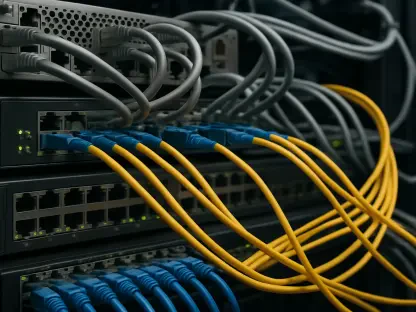In today’s hyper-connected digital landscape, where cyber threats evolve at an alarming pace, the notion of prioritizing only a majority of network assets while neglecting a smaller portion can have catastrophic consequences, making comprehensive security an absolute must. The 80/20 rule, a principle often embraced in IT to focus on the most impactful 80% of resources while sidelining the remaining 20%, might seem like a practical approach for efficiency. However, when applied to network security, this mindset opens the door to significant vulnerabilities. Sophisticated attackers don’t hesitate to exploit the unprotected minority—whether it’s legacy systems, unmanaged devices, or remote access points—turning a seemingly minor oversight into a major breach. With challenges like hybrid work models, multi-cloud architectures, and the rapid proliferation of IoT devices reshaping the threat landscape, partial security measures are no longer a viable option. The reality is stark: cybercriminals target the weakest link, regardless of its perceived importance, making comprehensive protection an absolute necessity for organizations aiming to safeguard their digital footprint.
Examining the Shortcomings of Conventional Security Models
Exposing the Flaws of Prioritization Strategies
The 80/20 rule has long been a guiding principle in IT for optimizing resource allocation, suggesting that focusing on the most critical 80% of assets delivers the bulk of value while the remaining 20% can often be deprioritized. Yet, in the realm of network security, this approach proves to be a dangerous misstep. Leaving even a small fraction of a network unsecured—be it outdated applications, third-party access points, or personal devices—creates a gateway for cyber threats. Modern attackers are adept at identifying and exploiting these overlooked areas, knowing that a single breach can compromise an entire system. The dynamic nature of today’s digital environments, driven by remote work and cloud adoption, further amplifies these risks, as traditional boundaries dissolve and attack surfaces expand. What might seem like a minor gap in coverage can quickly become the focal point of a devastating attack, underscoring the inherent flaw in applying such a selective strategy to something as critical as security.
Beyond the conceptual failure of prioritization, the practical implications of ignoring certain network segments reveal just how perilous this mindset can be. Consider the reality of sophisticated ransomware campaigns or phishing schemes that often target less-secured endpoints, such as contractor devices or legacy infrastructure, which fall into that dismissed 20%. These entry points, though seemingly insignificant, can lead to widespread damage, with costs running into millions due to data loss, downtime, and reputational harm. Research consistently shows that breaches often originate from these underprotected areas, proving that no part of a network is too small to warrant attention. As cyber threats grow in complexity, driven by advancements in malware and social engineering, the notion of “good enough” security becomes an outdated relic. Organizations must recognize that in a landscape where every connection is a potential vulnerability, achieving total coverage isn’t just ideal—it’s imperative to avoid catastrophic consequences.
Challenges of Disjointed Security Frameworks
One of the most glaring issues in traditional security models lies in the fragmented nature of networking and security operations, which often operate in silos with little coordination. This separation results in significant inefficiencies, as separate teams struggle to align on policies, share critical information, or respond to threats in a unified manner. Visibility across the network suffers when tools and processes aren’t integrated, leaving blind spots that attackers can easily exploit. For instance, a networking team might prioritize performance optimizations while a security team focuses on threat detection, leading to conflicting goals and inconsistent protections. Such fragmentation not only slows down response times during incidents but also heightens the risk of oversight, as gaps in communication prevent a holistic understanding of the network’s state. The lack of cohesion in these systems is a fundamental barrier to achieving robust defense mechanisms in an era of relentless cyber threats.
Adding to the complexity, maintaining separate technologies for networking and security often burdens organizations with increased operational costs and technical challenges. Studies indicate that a significant percentage of businesses find it increasingly difficult to manage these disjointed systems, as they require constant updates, patches, and manual interventions to ensure compatibility. This inefficiency translates into delayed threat mitigation and a higher likelihood of policy misconfigurations, which can inadvertently expose critical assets. The siloed approach also hampers the ability to enforce consistent security measures across diverse environments, such as branch offices or remote workforces, further widening the gap between protected and unprotected segments. As cyber risks continue to evolve, the need to dismantle these operational divides becomes clear, pushing for a more integrated framework that can address the full spectrum of network security without the pitfalls of fragmentation.
Addressing the Complexities of Today’s Digital Threats
Navigating New Risks and Wider Vulnerabilities
The rapid transformation of workplace dynamics, particularly with the rise of hybrid work models, has introduced unprecedented challenges to network security that render partial strategies utterly inadequate. Employees now access corporate resources from diverse locations and devices, often bypassing traditional perimeter defenses that once defined security boundaries. This shift, coupled with the widespread adoption of multi-cloud environments, significantly expands the attack surface, giving cybercriminals more opportunities to infiltrate systems through unsecured endpoints or misconfigured cloud settings. The proliferation of IoT devices, from smart office equipment to industrial sensors, adds yet another layer of complexity, as these often lack robust built-in security features. Attackers can exploit such weaknesses to gain footholds within networks, making it evident that focusing only on a majority of assets while neglecting others is a recipe for disaster in this interconnected digital age.
Further complicating the security landscape is the integration of advanced technologies like artificial intelligence, which, while offering immense potential for innovation, also introduces new vulnerabilities that demand comprehensive protection. AI-driven tools, increasingly used for everything from data analysis to customer service, can become targets for adversaries seeking to manipulate algorithms or steal sensitive training data. Additionally, the sheer volume of data generated and processed in modern setups—spanning cloud platforms, remote devices, and on-premises systems—creates a treasure trove for threat actors if not uniformly secured. The reality is that cyber threats no longer adhere to predictable patterns; they adapt to exploit any unprotected segment, whether it’s a single IoT device or an overlooked cloud application. This ever-widening scope of potential entry points necessitates a security approach that leaves no stone unturned, ensuring every aspect of the digital ecosystem is fortified against intrusion.
Shifting to Holistic Defense Mechanisms
The pressing need for complete visibility and protection across all network components has never been more apparent, as even the smallest blind spot can serve as a conduit for catastrophic breaches. Organizations must strive to monitor and secure every user, device, and application, regardless of where they reside or how they connect to the network. Traditional security frameworks, often rooted in static perimeter defenses, fall short in addressing the fluid nature of today’s threats, where remote access and cloud services blur conventional boundaries. A robust strategy involves deploying tools that provide end-to-end oversight, identifying potential risks before they escalate into full-blown incidents. By eliminating gaps in coverage—such as those affecting legacy systems or third-party contractors—businesses can significantly reduce their exposure to attacks, ensuring that no element of their digital infrastructure is left vulnerable to exploitation by increasingly cunning adversaries.
Equally critical is the adoption of security measures that adapt to the diverse contexts in which modern networks operate, ensuring protection without exception. This means implementing policies that account for user identity, device status, and application requirements to enforce least-privilege access across all interactions. For example, micro-segmentation can isolate critical assets, preventing lateral movement by attackers even if an initial breach occurs. Such granular control is essential for safeguarding the often-overlooked segments of a network, like unmanaged devices or operational technology in industrial settings. Moreover, centralized management of security policies, paired with localized enforcement, ensures consistency across varied environments, from corporate headquarters to remote home offices. As threats grow more sophisticated, the emphasis on comprehensive defense mechanisms becomes a cornerstone of resilience, enabling organizations to stay ahead of risks that target any unprotected corner of their digital landscape.
Ensuring Seamless Functionality Alongside Protection
A vital aspect of modern network security lies in striking a balance between robust protection and uncompromised performance, especially as hybrid work environments demand seamless connectivity for users across the globe. Employees accessing applications from disparate locations expect fast, reliable performance without the hindrance of overly restrictive security protocols that slow down workflows. If security measures introduce latency or disrupt access, user frustration can lead to workarounds that bypass safeguards, inadvertently increasing risks. Therefore, solutions must be designed to optimize application access while maintaining stringent defenses, ensuring that productivity isn’t sacrificed for safety. This dual focus is particularly crucial for supporting modern workloads, including resource-intensive tools like generative AI applications, which require both high-speed connectivity and airtight security to function effectively in distributed settings.
Achieving this equilibrium involves leveraging advanced technologies that enhance both security and efficiency without trade-offs, catering to the expectations of a mobile, agile workforce. Global networks of points of presence can reduce latency by routing traffic through optimized paths, while protocols designed for speed and encryption ensure data remains secure during transit. Additionally, transitioning from outdated VPN systems to cloud-based zero trust architectures can provide secure, direct access to applications without the bottlenecks of traditional setups. The goal is to create an environment where security enhances rather than hinders performance, meeting the needs of users who rely on instant access to SaaS platforms or collaborative tools from any location. By prioritizing this balance, organizations can foster trust in their security frameworks, ensuring that protective measures support rather than obstruct the seamless operation of critical business functions in an increasingly distributed digital world.









